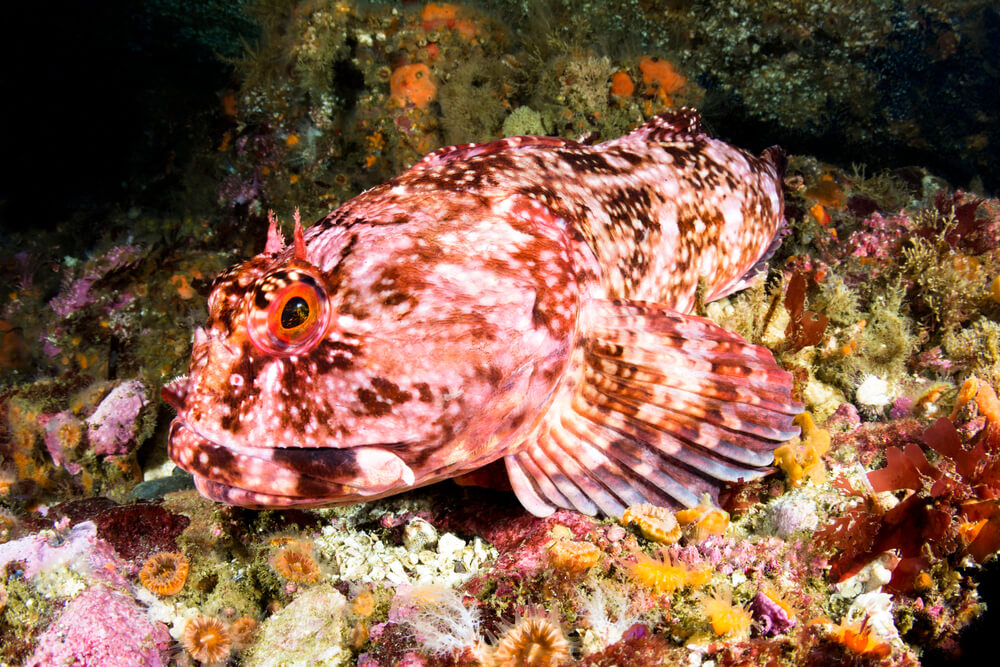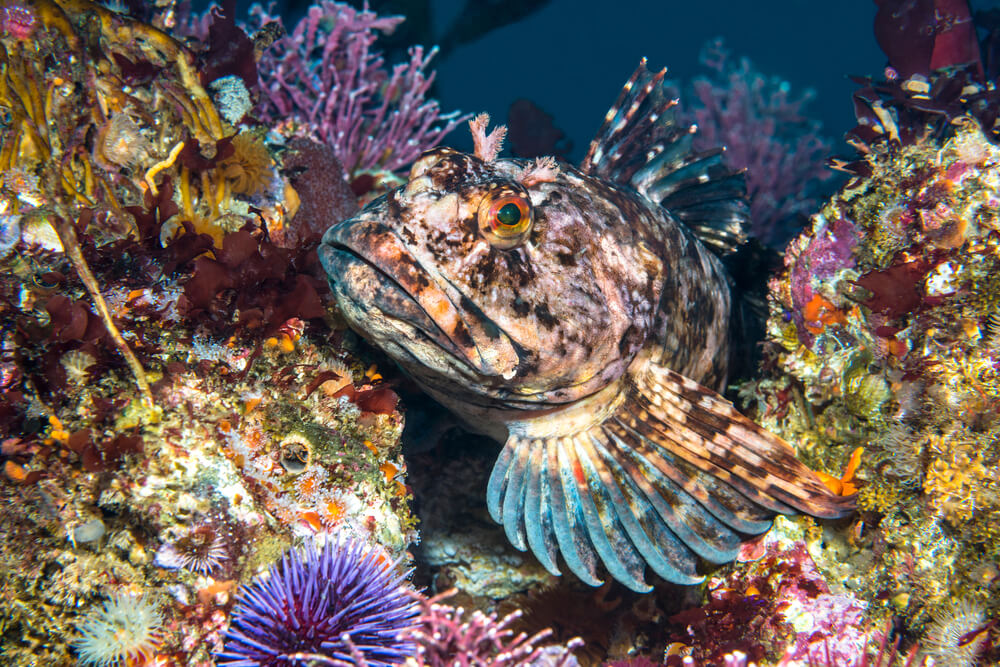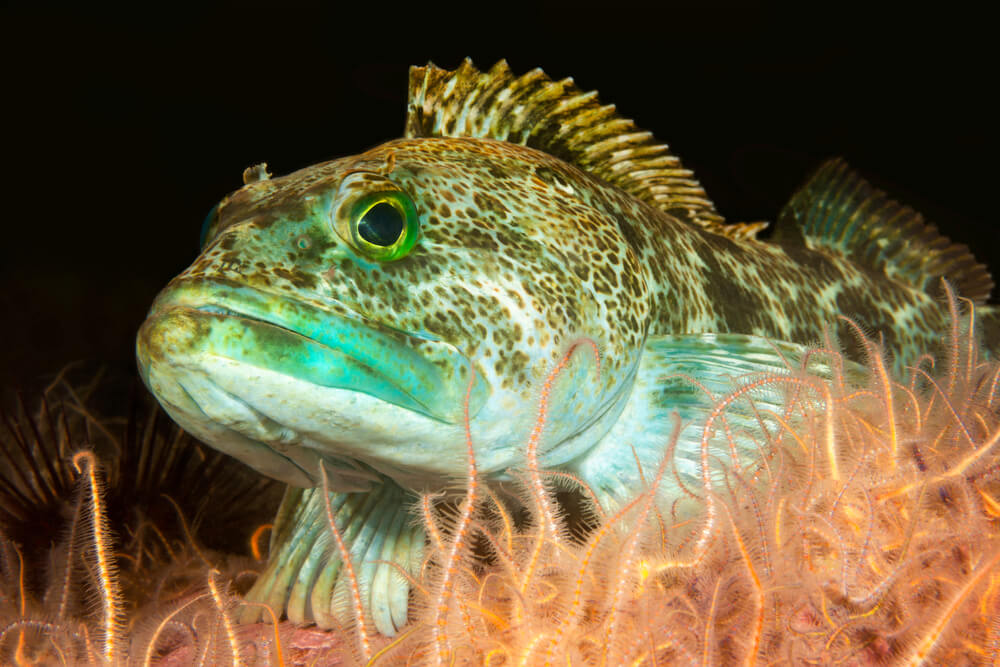
The cabezon (Scorpaenichthys marmoratus) is a species of sculpin, the genus name translates literally as “scorpion fish”, they are not truly a scorpionfish.
The cabezon was first formally described as Hemitripterus marmoratus in 1854 by the American physician and ichthyologist William Orville Ayres when it was found in California.
Habitat of The Cabezon Fish:
This fish is found Pacific Ocean from Alaska to Baja California. The depth range starts from 0–200 meters including rocky, sandy, and muddy bottoms.
Description of The Cabezon Fish:
The cabezon fish is a scaleless fish with a broad bony support extending from the eye. It has 11 spines. The cabezon has a spine before the eye. It has flaps also behind the eye. The mouth is wide with small teeth. The colors are red, green, and brown. The males are red while the females are green. The length can reach 99 cm and can weigh over 14 kg. The name cabezon comes from Spanish meaning the large head compared to body size.

Diet:
The primary food source of the cabezon fish is crustaceans and mollusks, and small fishes from the water column.



Behavior And Lifespan:
They are solitary animals laying on sea rocks, sea floor waiting for prey. They have lots of darker mottling to help with the camouflage. They are solitary animals. Cabezon is also known to be territorial and aggressive, especially during spawning season, when males guard their nests from other males. They are not active swimmers. They are predator hunters waiting for fish to pass and then striking in light quickness.
Reproduction Of Cabezon Fish:
The spawning season occurs between October and March, peaking in January where females lay eggs on rocky habitats with males guarding the eggs until hatching. After hatching, the larvae develop into silvery fish and after a few months, they move to rocky and sandy bottoms.
Cool Facts:
- They are hunted by larger fish and mammals like seals and orcas.
- Prized in a fish game.
- Their roe is toxic to humans.
- They inhabit tops of rocky ledges as opposed to lingcod.


What a fish this cabezon fish is,it’s like the sculpin and goosefish combined with it’s bizarre hunting technique.
Other Creatures You Might Like:
Deep Sea Lumpfish: Nature’s Underwater Oddity
Discover the Mystery of Goosefish: Masters of Camouflage
Clingfish: Uncovering the Diversity and Adaptability of These Small Marine Creatures
The deep-sea Batfish: A Weird and Wonderful Underwater Creature
A Fish of Distinction: Exploring the Enigmatic John Dory
Incredible Adaptations of Deep Sea Frogfish: A Closer Look
The long-horned cowfish: a bizarre small fish!
Everything You Need to Know About Needlefish
The Banggai Cardinalfish: A True Marvel Of Coloration
Discovering the Enigmatic Striped Burrfish
The Deep Sea Ghost Shark: The Living Fossil
The Whalefish: The Deep Dark-Dwelling Fish
Stoplight Loosejaw: The Bottom-Dwelling Dragonfish
The Glass Squid: The Transparent Deep Squid
The Owlfish: The Monster With Large Eyes
Secrets Of The Deep: The Black Sea Nettle
Exploring the World of Snipe Eel
The Pacific Hagfish: Nature’s Slime Prodigy
The Basket Star: Nature’s Living Tapestry
Unveiling the Enchanting World of Firefly Squid
Discover the Enchanting Flapjack Octopus
Discover the Fascinating Longspine Snipefish
Exploring the Elegance and Mystery of The Blacktip Reef Shark
The Giant Ostracod:The Bizzare Form
Eelpout, The Bottom Dwelling Fish
Intriguing Facts About Monkeyface Prickleback Fish
The Northern Clingfish: A Master of Camouflage
Dandelion Siphonophore: The Creepy Creature
Chondrocladia lyra: The deep sea harp sponge
The Filetail Catshark: The Shark Beauty
Discover the Fascinating World of Pacific Spiny Lumpsucker
Exploring Deep Sea Wonders: Sixgill Shark
The Supergiant Amphipod: The Deepest Amphipod Alive
Exploring the Fascinating World of Acorn Barnacle
